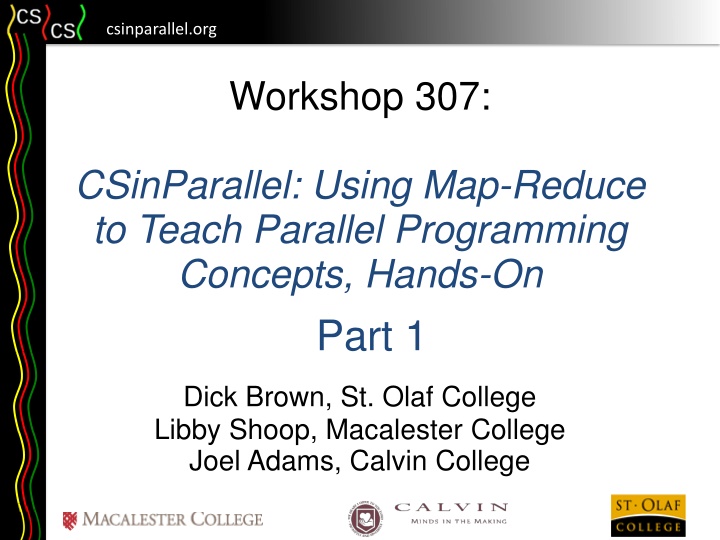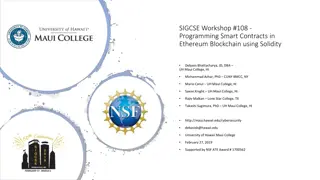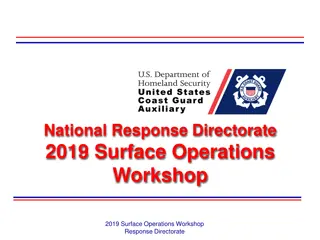
Teaching Parallel Programming Concepts Using Map-Reduce
Explore the use of map-reduce computing in teaching parallel programming concepts through hands-on exercises and simplified interfaces like WebMapReduce (WMR). Learn about the history, concepts, and practical applications of map-reduce, including the two-stage process with mapper and reducer functions. Discover the importance of integrating map-reduce into educational curriculums for foundation to advanced courses.
Download Presentation

Please find below an Image/Link to download the presentation.
The content on the website is provided AS IS for your information and personal use only. It may not be sold, licensed, or shared on other websites without obtaining consent from the author. If you encounter any issues during the download, it is possible that the publisher has removed the file from their server.
You are allowed to download the files provided on this website for personal or commercial use, subject to the condition that they are used lawfully. All files are the property of their respective owners.
The content on the website is provided AS IS for your information and personal use only. It may not be sold, licensed, or shared on other websites without obtaining consent from the author.
E N D
Presentation Transcript
csinparallel.org Workshop 307: CSinParallel: Using Map-Reduce to Teach Parallel Programming Concepts, Hands-On Part 1 Dick Brown, St. Olaf College Libby Shoop, Macalester College Joel Adams, Calvin College
csinparallel.org Workshop site CSinParallel.org -> Workshops -> WMR Workshop See also workshop handout
csinparallel.org Goals Part 1 Introduce map-reduce computing, using the WebMapReduce (WMR) simplified interface to Hadoop Why use map-reduce in the curriculum? Hands-on exercises with WMR for foundation courses Part 2 Use of WMR for intermediate and advanced courses What s under the hood with WMR A peek at Hadoop Hands-on exercises for more advanced use
csinparallel.org Introduction to Map-Reduce Computing
csinparallel.org History The computational model of using map and reduce operations was developed decades ago, for LISP Google developed MapReduce system for search engine, published (Dean and Ghemawat, 2004) Yahoo! created Hadoop, an open-source implementation (under Apache); Java mappers and reducers
csinparallel.org Map-Reduce Concept
csinparallel.org The map-reduce computational model Map-reduce is a two-stage process with a "shuffle twist" between the stages. Stages are controlled by functions: mapper() , reducer()
csinparallel.org The map-reduce computational model mapper() function: Argument is one line of input from a file Produces (key, value) pairs Example: word-count mapper() "the cat in the hat --> [mapper for this line] ("the", "1"), ("cat", "1"), ("in", "1"), ("the", "1"), ("hat", "1")
csinparallel.org The map-reduce computational model Shuffle stage: group all mappers (key, value) pairs together that have the same key, and feed each group to its own call of reduce() Input: all (key,value) pairs from all mappers Output: Those pairs rearranged, sent to calls of reduce() according to key Note: Shuffle also sorts (optimization)
csinparallel.org The map-reduce computational model reducer() function: Receives all key-value pairs for one key Produces an aggregate result Example: word-count reducer() ("the", "1"), ("the", "1") --> [reducer for "the"] ("the", "2")
csinparallel.org The map-reduce computational model In map-reduce, a programmer codes only two functions (plus config information) A model for future parallel-programming frameworks Underlying map-reduce system reuses code for Partitioning the data into chunks and lines, Runs mappers/reducers where the chunks are local Moving data between mappers and reducers Auto-recovering from any crashes that may occur ... Optimized, Distributed, Fault-tolerant, Scalable
csinparallel.org The map-reduce computational model Optimized, Distributed, Fault-tolerant, Scalable 1. mappers 2. shuffle 3. reducers Local I/O Global I/O
csinparallel.org Demo of WMR
csinparallel.org Why teach map-reduce?
csinparallel.org Why map-reduce for teaching notions of parallelism/concurrency? Concepts: data parallelism; task parallelism; locality; effects of scale; example effective parallel programming model; distributed data with redundancy for fault tolerance; ...
csinparallel.org Why map-reduce for teaching notions of parallelism/concurrency? Real-World: Hadoop widely used Exciting: the appeal of Google, Facebook, etc. Useful: for appropriate applications Powerful: scalability to large clusters, large data
csinparallel.org Why WMR? Introduce concepts of parallelism Low bar for entry, feasible for CS1 (and beyond) Capture the imaginations of students Supports rapid introduction of concepts of parallelism for every CS student Intro module designed for 1-3 days of class
csinparallel.org WebMapReduce (WMR) Simplified web interface for Hadoop computations Goals: Strategically Simple suitable for CS1, but not a toy Configurable write mappers/reducers in any language Accessible web application Multi-platform, front-end and back-end
csinparallel.org WMR Features (Briefly) Testing interface Error feedback Bypasses Hadoop -- small data only! Students enter the following information: choice of language data to process definition of mapper in that language definition of reducer in that language
csinparallel.org WMR system information Languages currently supported: Java, C++, Python, Scheme, C, C#, Javascript R coming soon Back ends to date: local cluster, Amazon EC2 cloud images Version limits and more back ends coming soon More details about the system in Part 2 of the workshop
csinparallel.org Teaching map-reduce with WMR in the introductory sequence
csinparallel.org Kinesthetic student activity Visualizations of map-reduce computations are enough for some students, but not all An in-class activity to act out the map/shuffle/reduce process helps others Also helpful: images of clusters; sequential versions; context of well-known web services
csinparallel.org Materials available CSinParallel module: Map-reduce Computing for Introductory Students using WebMapReduce See csinparallel.org
csinparallel.org Overview of suggested exercises Available on the csinparallel.org site Run word count (provided), with small and large data Modify, run variations on word count: strip punctuation; case insensitive; etc. Alternative exercises
csinparallel.org Additional exercises Beyond your first simple exercises, consider exploring the following: Various data sets Note: Please avoid large Gutenberg "groups" for this workshop Extended set of exercises for CS1 (text analysis)
csinparallel.org Quick questions/comments so far?
csinparallel.org Hands-on Module exercises Extended exercise set Data sets available /shared/MovieLens2/movieRatings /shared/gutenberg/WarAndPeace.txt /shared/gutenberg/CompleteShakespeare.txt






